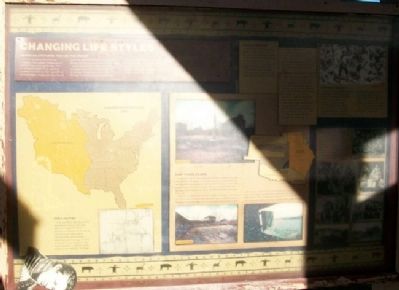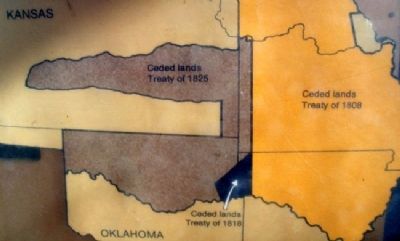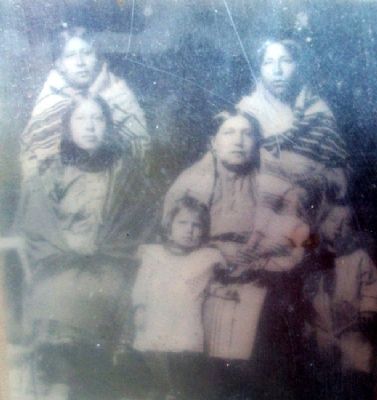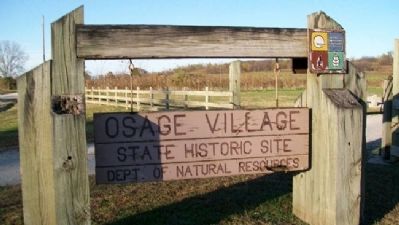Near Fair Haven in Vernon County, Missouri — The American Midwest (Upper Plains)
Changing Life Styles
American Attitudes Toward The Osage
In March 1804, the United States took possession of the Louisiana Territory, almost doubling the size of the United States. This provided growing space for an expanding population. The Lewis and Clark expedition left that year to explore the Missouri River. The U.S. government rejected the trade monopolies of the Spanish and Lisa's monopoly with the Osage ended.
At first, the American attitude toward Indians was similiar to that of the French and Spanish. But attitudes changed rapidly around 1808. Although the authorities did not like the Osage raids on other tribes, it was the raids on the ever-increasing American settlers that brought about the wrath of the new government. This new attitude and the resulting policies changed forever the life style of the Osage.
Zebulon Pike
In the summer of 1806, Zebulon Pike ascended the Missouri and Osage rivers on his way to the Rocky Mountains and Mexico. On this trip, he returned several Osage Indians previously held captive and spent several days with the Osage. He left an account of this jouney and provided much information on the river and the location of sites relating to the Osage.
Osage Treaties
Another reason for Fort Osage was to help the Americans obtain the Osage lands. On September 12, 1808, 75 Big Osage and Little Osage chiefs and warriors came to a council arranged by Clark. The proposed treaty would provide a dividing line between the American land and the Osage hunting grounds. Two days later, the Osage agreed to the terms of the treaty.
The treaty collapsed when the Arkansas River Osage said they had no part in the treaty and others complained they did not understand it. The treaty was signed again on November 10, 1808, with the Arkansas River Osage ratifying it on August 31, 1809.
The Osage had been caught in a vicious circle. The only way to pay for the European goods they depended upon was to trade furs and skins. As they gave up land, they had less areas to hunt and game grew scarce. Raiding and warfare was a way of life for warriors, but victimized settlers filed claims against the government for losses. As the Osage obtained goods on credit and could not repay their debts, the government forced them to give up more and more land.
In 1825, the Osage ceded their remaining land in Missouri.
Fort Osage (Clark)
In May 1808, the U.S. War Department decided to establish a fort and trading post for the Osage. The fort, built along the Missouri River just east of present-day Kansas City, was named after General William Clark but was better known as Fort Osage. After its completion, Clark sent a message to the Osage telling them to abandon their villages and move to the fort.
One of the purposes of the fort was to confine the Osage to the western part of the state and make it more difficult for them to raid settlements in the eastern part of the state. Until now, the Osage had gone yearly to St. Louis to trade, but that would end with the construction of the new fort. Many of the Osage soon went back to their own villages. In order to trade with the Osage, a trading post was built on the Marais des Cygnes River. It was built under the direction of George Sibley, head of Fort Osage.
Harmony Mission
In 1819, the Osage began to request missionaries. These requests may have been an attempt to understand the white man and the way he seemed to control the world.
A mission party, soon named Harmony, left New York in March 1821. They established Harmony Mission in August on the banks of the Marais des Cygnes River near the location of the trading post under construction by Sibley. The mission included a communal building, schoolhouse, mill, and 10 houses. After many of the Osage moved to Kansas and Oklahoma, the mission closed in 1827.
A Way of Life Ends
After being pushed onto new lands several times, the Osage found themselves on a small reservation in Oklahoma. By the late 19th century, their hunting, warring, and nomadic life style was a thing of the past. Although they were once proud, daring warriors, they peacefully adapted to the new life style forced upon them.
Erected by Missouri State Parks.
Topics. This historical marker is listed in these topic lists: Government & Politics • Native Americans • Peace • Settlements & Settlers. A significant historical month for this entry is March 1804.
Location. 37° 58.879′ N, 94° 12.539′ W. Marker is near Fair Haven, Missouri, in Vernon County. Marker is in the kiosk located about 300 feet northeast of the parking lot at Osage Village State Historic Site, off Road C, about 2 miles west of Fair Haven. Touch for map. Marker is in this post office area: Harwood MO 64750, United States of America. Touch for directions.
Other nearby markers. At least 8 other markers are within 12 miles of this marker, measured as the crow flies. Archaeology (here, next to this marker); The Osage Indians (here, next to this marker); The Osage and the Fur Trade (here, next to this marker); Encounter With Europeans: The Change Begins (here, next to this marker); Osage Sites in the Area (about 600 feet away, measured in a direct line); Harmony Mission (approx. 11.2 miles away); The Town That Coal Built (approx. 11˝ miles away); Veterans Memorial (approx. 12 miles away). Touch for a list and map of all markers in Fair Haven.
Also see . . .
1. Osage Village State Historic Site. Missouri State Parks website entry (Submitted on November 26, 2012, by William Fischer, Jr. of Scranton, Pennsylvania.)
2. The Osage Nation. Website homepage (Submitted on November 26, 2012, by William Fischer, Jr. of Scranton, Pennsylvania.)
Credits. This page was last revised on May 22, 2022. It was originally submitted on November 26, 2012, by William Fischer, Jr. of Scranton, Pennsylvania. This page has been viewed 485 times since then and 16 times this year. Photos: 1, 2, 3. submitted on November 26, 2012, by William Fischer, Jr. of Scranton, Pennsylvania. 4. submitted on November 25, 2012, by William Fischer, Jr. of Scranton, Pennsylvania. 5. submitted on March 16, 2011, by William Fischer, Jr. of Scranton, Pennsylvania.




